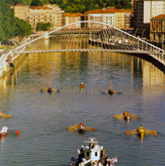The world's gas
>
Creation of infrastructures
>
Europe
Europe
The increasing approval for the construction of LNG terminals by companies and governments in 2007 has led to the appearance of many new projects, and good progress in those under construction.
During the year projects have been developed in Russia, Germany, Poland (at Swinoujscie), Lithuania, the Netherlands (4Gas LNG, at Rotterdam, a project for which the investment decision was taken in December 2007), the United Kingdom, France and Italy, also enlargement of the Zeebrugge terminal, in Belgium, and others.
The viability analysis of these options is motivated mainly by the desire to avoid excessive dependence on the gas pipeline of sometimes just one supplier, and thus to increase the security of supply and freedom of commercial choice.
Norway is studying the possibility of building two new export gas pipelines. One of them, possibly for supply to the United Kingdom, Belgium or the Netherlands, would be in operation in 2010. The second would cross the country to supply Sweden and Denmark. If the latter goes ahead, it would be working in 2012.
Permission was given in December for the construction of a new terminal in the United Kingdom. The terminals in operation, those which are under construction and those which have already sold some of their capacity, add up to a potential of 53.4 bcm a year. It should be borne in mind that the demand for natural gas in this country averages around 90-95 bcm a year. When national production and the gas which arrives or may arrive by gas pipeline from abroad is taken into account, it is not surprising that some analysts are beginning to talk of overcapacity. In fact, many bidders want to get involved in the growing demand for gas in this country. For example, the owners of Interconnector announced their intention in October to increase its import and export capacity. In imports, it will go from 68 to 74 million cubic metres a day (an increase of 2 bcm a year).
In France, construction continues on the Fos Cavaou project in the Mediterranean. Another five projects have been submitted, all separate from GDF, although it is admitted not all of them will be built. One of them, situated in Bordeaux, is sponsored by the French subsidiary of Endesa. The one furthest ahead is the EDF, at Dunkirk, which is due to start supplying gas in 2012.
The Midcat gas pipeline is one of the main enterprises occupying the minds of energy managers in France and Spain. This project would enable a new connection between the French and Spanish gas systems, connecting the two important territories of the Midi and Catalonia.
In November, Italy signed an agreement with Algeria to build the Galsi gas pipeline, which was proposed a few years earlier. The pipeline will leave the Algerian coast at El Kala, travel to the island of Sardinia, and cross it to reach the Italian mainland near Piombino, where it will join the country’s gas pipeline.
In this country, several LNG plant projects submitted at the start of the millennium have still not been approved. Two of them are by the Gas Natural company. The terminal project proposed by BG in Brindisi has been postponed until the end of October by the Italian Government, which has insisted on a more thorough environmental impact investigation.
However, construction of the Rovigo plant (offshore, in the Adriatic) is proceeding, and it will be ready in 2008 with a capacity of 8 bcm.
Eni and Gazprom signed a memorandum in the middle of the year in which Italy subscribed to construction of the South Stream, an idea parallel to that of the gas pipeline under construction between Russia and Germany, but from the Black Sea.
An important part of the ITGI corridor (Italy-Turkey-Greece Interconnection), and specifically the section from Turkey to Greece, was inaugurated in November. It connects the Turkish city of Bursa with the Greek city of Komotini. It is only supplying Greece at present. 300 km long, in 2012 it will be used to supply Italy with up to 8 bcm of natural gas from the Caspian Sea and Middle East area. It is already a link between Azerbaijan and European consumers beyond the Bosphorous.
The viability analysis of these options is motivated mainly by the desire to avoid excessive dependence on the gas pipeline of sometimes just one supplier, and thus to increase the security of supply and freedom of commercial choice.
Norway is studying the possibility of building two new export gas pipelines. One of them, possibly for supply to the United Kingdom, Belgium or the Netherlands, would be in operation in 2010. The second would cross the country to supply Sweden and Denmark. If the latter goes ahead, it would be working in 2012.
Permission was given in December for the construction of a new terminal in the United Kingdom. The terminals in operation, those which are under construction and those which have already sold some of their capacity, add up to a potential of 53.4 bcm a year. It should be borne in mind that the demand for natural gas in this country averages around 90-95 bcm a year. When national production and the gas which arrives or may arrive by gas pipeline from abroad is taken into account, it is not surprising that some analysts are beginning to talk of overcapacity. In fact, many bidders want to get involved in the growing demand for gas in this country. For example, the owners of Interconnector announced their intention in October to increase its import and export capacity. In imports, it will go from 68 to 74 million cubic metres a day (an increase of 2 bcm a year).
In France, construction continues on the Fos Cavaou project in the Mediterranean. Another five projects have been submitted, all separate from GDF, although it is admitted not all of them will be built. One of them, situated in Bordeaux, is sponsored by the French subsidiary of Endesa. The one furthest ahead is the EDF, at Dunkirk, which is due to start supplying gas in 2012.
The Midcat gas pipeline is one of the main enterprises occupying the minds of energy managers in France and Spain. This project would enable a new connection between the French and Spanish gas systems, connecting the two important territories of the Midi and Catalonia.
In November, Italy signed an agreement with Algeria to build the Galsi gas pipeline, which was proposed a few years earlier. The pipeline will leave the Algerian coast at El Kala, travel to the island of Sardinia, and cross it to reach the Italian mainland near Piombino, where it will join the country’s gas pipeline.
In this country, several LNG plant projects submitted at the start of the millennium have still not been approved. Two of them are by the Gas Natural company. The terminal project proposed by BG in Brindisi has been postponed until the end of October by the Italian Government, which has insisted on a more thorough environmental impact investigation.
However, construction of the Rovigo plant (offshore, in the Adriatic) is proceeding, and it will be ready in 2008 with a capacity of 8 bcm.
Eni and Gazprom signed a memorandum in the middle of the year in which Italy subscribed to construction of the South Stream, an idea parallel to that of the gas pipeline under construction between Russia and Germany, but from the Black Sea.
An important part of the ITGI corridor (Italy-Turkey-Greece Interconnection), and specifically the section from Turkey to Greece, was inaugurated in November. It connects the Turkish city of Bursa with the Greek city of Komotini. It is only supplying Greece at present. 300 km long, in 2012 it will be used to supply Italy with up to 8 bcm of natural gas from the Caspian Sea and Middle East area. It is already a link between Azerbaijan and European consumers beyond the Bosphorous.
Annual
Report
07
Annual Report 2.007: Sedigas - The Spanish Gas Association


